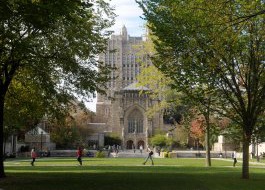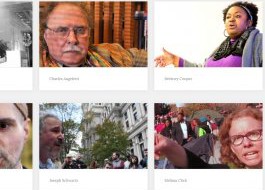 Students walk on the Yale campus in New Haven, Conn. Jessica Hill/AP
Students walk on the Yale campus in New Haven, Conn. Jessica Hill/AP
On Sunday morning, headlines around the world announced that “Yale administrators” had decided to rename Calhoun College, but the press was mistaken.
It was Yale students who renamed Calhoun College after years of sustaining a social movement that grew to include many allies among faculty, staff and the New Haven community.
Along the way, students ignited a firestorm of opposition, changed hearts and minds and persevered — sometimes at enormous personal cost.
Twenty years ago at Yale, it seemed to me enough to mock what John C. Calhoun, class of 1804, stood for — proslavery values, eternal white supremacy and treason against the Republic — by having an African-American master or two in Calhoun and racial diversity among students in the college.
Like many historians, I believed that the best way to counter racism’s legacy was to expose it. American racial progress would inevitably wash over the memorialization of Calhoun, whose presence would serve to remind us of the sins of the past.
But I was wrong. By 2015, the protean nature of white supremacy meant that Calhoun symbolized not the past, but the present: the murder of Trayvon Martin, the failure of justice in Ferguson and Dylan Roof’s reenactment of Calhoun’s values.
Why, Yale students demanded to know, should they sleep, study and eat in the shadow of Calhoun, a man whose legacy, in the words of President Salovey “fundamentally conflicts with Yale’s mission and values?”
 A bust of former U.S. Vice President John C. Calhoun sits in his home office on the grounds of his cotton plantation where he laid some of the ideological groundwork for the secession of slave-owning southern states in the American Civil War. Jonathan Ernst/Reuters
A bust of former U.S. Vice President John C. Calhoun sits in his home office on the grounds of his cotton plantation where he laid some of the ideological groundwork for the secession of slave-owning southern states in the American Civil War. Jonathan Ernst/Reuters
The cost of honoring Calhoun forced them to affiliate with him: to live with him every day, to wear T-shirts bearing his name and to sign their names in the Yale tradition by appending “Calhoun College, 2016.” They reasoned that if Yale had made a choice to honor Calhoun, it could make a choice to rename the college.
Yale students taught us that we are not slaves to our history.
They exercised their right to free speech to protest Yale’s racial climate, symbolized by administrators’ refusal to rename Calhoun, with the November 2015 March of Resilience.
Chanting, “We out here. We been here. We ain’t leaving. We are loved,” they drew on social movement history to build alliances, to share the work, to stay on message and to act strategically. Generations of students before them had protested the Calhoun name; they had “been here;” yet, nothing had changed.
Now, thousands of students were out there; yet, administrators retained the Calhoun name. But the students didn’t leave.
In Battell Chapel in the spring of 2016, they poignantly told University President Peter Salovey of the pain that Yale had inflicted by failing to rename Calhoun, and then they held a renaming ceremony. The name that stuck was FKAC, the college formerly known as Calhoun. Still, Yale held its ground.
Ironically, as students exercised their free speech, a few condemned their protests as an attempt to shut down free speech. When students argued that they should not be forced to affiliate with white supremacy by being saddled with Calhoun’s name, some faculty mocked them for seeking “safe spaces.”
When students bravely denounced the views of Yale authority figures, those figures denounced the students for not agreeing with them and mounted public campaigns against them, calling them “snowflakes.” Yale students didn’t melt.
Finally — perhaps after the administration watched protestors sign up prefrosh during Bulldog Days — Yale decided to follow other universities’ leads and establish guidelines for renaming practices. John Witt ’94 LAW ’99 GRD ’00 and his task force worked nonstop to draw up neutral precepts to guide Yale.
 Glenda Gilmore. _
Glenda Gilmore. _
In accordance with those guidelines, a subsequent committee found that Calhoun’s principal legacy — unwavering support for slavery and white supremacy — meant that in 1931 Yale had erred by naming a residential college in his honor.
Yale will long remember those students whose vigorous exercise of free speech and personal bravery resulted in Hopper College. You are loved.
Two decades ago, when I accepted a position in Yale’s History Department, my mentor’s first response was, “You will learn so much from your students!”
True enough, I thought. I never expected that my Yale students would make history. I never dreamed that they would teach me the meaning of history itself.
Glenda Gilmoreis a professor of history. Contact her at [email protected] .
This column does not necessarily reflect the opinion of Business Insider.
Read the original article on Yale Daily News. Copyright 2017. Follow Yale Daily News on Twitter.




